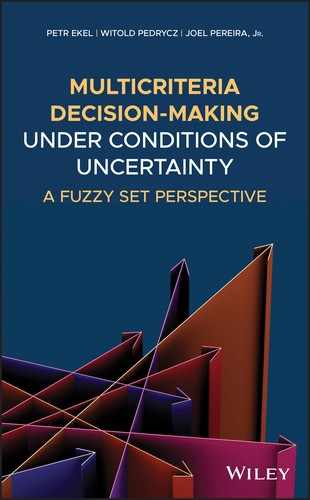Book Description
A guide to the various models and methods to multicriteria decision-making in conditions of uncertainty presented in a systematic approach
Multicriteria Decision-Making under Conditions of Uncertainty presents approaches that help to answer the fundamental questions at the center of all decision-making problems: "What to do?" and "How to do it?" The book explores methods of representing and handling diverse manifestations of the uncertainty factor and a multicriteria nature of problems that can arise in system design, planning, operation, and control. The authors—noted experts on the topic—and their book covers essential questions, including notions and fundamental concepts of fuzzy sets, models and methods of multiobjective as well as multiattribute decision-making, the classical approach to dealing with uncertainty of information and its generalization for analyzing multicriteria problems in condition of uncertainty, and more.
This comprehensive book contains information on "harmonious solutions" in multiobjective problem-solving (analyzing <X, F> models), construction and analysis of <X, R> models, results aimed at generating robust solutions in analyzing multicriteria problems under uncertainty, and more. In addition, the book includes illustrative examples of various applications, including real-world case studies related to the authors’ various industrial projects. This important resource:
- Explains the design and processing aspect of fuzzy sets, including construction of membership functions, fuzzy numbers, fuzzy relations, aggregation operations, and fuzzy sets transformations
- Describes models of multiobjective decision-making (<X. M> models), their analysis on the basis of using the Bellman-Zadeh approach to decision-making in a fuzzy environment, and their diverse applications, including multicriteria allocation of resources
- Investigates models of multiattribute decision-making (<X, R> models) and their analysis on the basis of the construction and processing of fuzzy preference relations as well as demonstrating their applications to solve diverse classes of multiattribute problems
- Explores notions of payoff matrices and fuzzy-set-based generalization and modification of the classic approach to decision-making under conditions of uncertainty to generate robust solutions in analyzing multicriteria problems
Written for students, researchers and practitioners in disciplines in which decision-making is of paramount relevance, Multicriteria Decision-Making under Conditions of Uncertainty presents a systematic and current approach that encompasses a range of models and methods as well as new applications.
Table of Contents
- Cover
- Preface
- 1 Decision‐Making in Problems of System Design, Planning, Operation, and Control
- 1.1 Decision‐Making and Its Support
- 1.2 Problems of Optimization and Decision‐Making
- 1.3 Uncertainty Factor and Its Consideration
- 1.4 Multicriteria Decision‐Making: Multiobjective and Multiattribute Problems
- 1.5 Group Decision‐Making: Basic Notions
- 1.6 Fuzzy Sets in Problems of Decision‐Making
- 1.7 Conclusions
- References
- 2 Notions and Concepts of Fuzzy Sets
- 2.1 Sets and Fuzzy Sets: A Fundamental Departure from the Principle of Dichotomy
- 2.2 Interpretation of Fuzzy Sets
- 2.3 Membership Functions and Classes of Fuzzy Sets
- 2.4 Information Granules and Granular Computing
- 2.5 Formal Platforms of Information Granularity
- 2.6 Intervals and Calculus of Intervals
- 2.7 Fuzzy Numbers and Intervals
- 2.8 Linguistic Variables
- 2.9 A Generic Characterization of Fuzzy Sets: Some Fundamental Descriptors
- 2.10 Coverage of Fuzzy Sets
- 2.11 Matching Fuzzy Sets
- 2.12 Geometric Interpretation of Sets and Fuzzy Sets
- 2.13 Fuzzy Set and Its Family of α‐Cuts‐Cuts
- 2.14 Fuzzy Sets of Higher Type and Fuzzy Order
- 2.15 Operations on Fuzzy Sets
- 2.16 Triangular Norms and Triangular Conorms as Models of Operations on Fuzzy Sets
- 2.17 Negations
- 2.18 Fuzzy Relations
- 2.19 The Concept of Relations
- 2.20 Fuzzy Relations
- 2.21 Properties of the Fuzzy Relations
- 2.22 Conclusions
- References
- 3 Design and Processing Aspects of Fuzzy Sets
- 4 <X, F> Models of Multicriteria Decision‐Making and Their Analysis> Models of Multicriteria Decision‐Making and Their Analysis
- 4.1 Models of Multiobjective Decision‐Making
- 4.2 Pareto Optimal Solutions
- 4.3 Approaches to Incorporating Decision‐Maker Information
- 4.4 Methods of Multiobjective Decision‐Making
- 4.5 Bellman–Zadeh Approach to Decision‐Making in a Fuzzy Environment and Its Application to Multicriteria Decision‐Making
- 4.6 OWA Operator Applied to Multiobjective Decision‐Making
- 4.7 Multiobjective Allocation of Resources and Their Shortages
- 4.8 Practical Examples of Analyzing Multiobjective Problems
- 4.9 Conclusions
- References
- 5 <X, R> Models of Multicriteria Decision‐Making and Their Analysis> Models of Multicriteria Decision‐Making and Their Analysis
- 5.1 Introduction to Preference Modeling with Binary Fuzzy Relations
- 5.2 Construction of Fuzzy Preference Relations
- 5.3 Preference Formats
- 5.4 Transformation Functions and Their Application to Unifying Different Preference Formats
- 5.5 Optimization Problems with Fuzzy Coefficients and Their Analysis
- 5.6 <X, R> Models of Multicriteria Decision‐Making> Models of Multicriteria Decision‐Making
- 5.7 Techniques for Analyzing <X, R> Models> Models
- 5.8 Practical Examples of Analyzing <X, R> Models> Models
- 5.9 Conclusions
- References
- 6 Dealing with Uncertainty of Information
- 6.1 Characterization of the Classic Approach to Dealing with Uncertainty of Information
- 6.2 Payoff Matrices and Characteristic Estimates
- 6.3 Choice Criteria and Their Application
- 6.4 Elements of Constructing Representative Combinations of Initial Data, States of Nature, or Scenarios
- 6.5 Application Example
- 6.6 Conclusions
- References
- 7 Generalization of the Classic Approach to Dealing with Uncertainty of Information and General Scheme of Multicriteria Decision‐Making under Conditions of Uncertainty
- 7.1 Generalization of the Classic Approach to Dealing with Uncertainty of Information in Multicriteria Decision Problems
- 7.2 Consideration of Choice Criteria of the Classic Approach to Dealing with Uncertainty of Information as Objective Functions within the Framework of <X, F> Models> Models
- 7.3 Construction of Objectives and Elaboration of Representative Combination of Initial Data, States of Nature, or Scenarios using Qualitative Information
- 7.4 General Scheme of Multicriteria Decision‐Making under Conditions of Uncertainty
- 7.5 Application Studies
- 7.6 Conclusions
- References
- Index
- End User License Agreement
